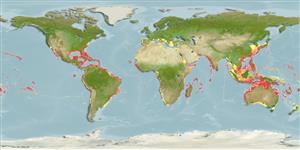Actinopterygii (ray-finned fishes) >
Perciformes (Perch-likes) >
Carangidae (Jacks and pompanos) > Naucratinae
Etymology: Elagatis: Greek, elakate, -es = distaff, cane (Ref. 45335).
Environment / Climate / Range
Ecology
Marine; reef-associated; depth range 0 - 150 m (Ref. 9710), usually 2 - 10 m (Ref. 40849). Subtropical, preferred 28°C (Ref. 107945); 42°N - 41°S, 95°W - 156°E (Ref. 54429)
Western Atlantic: Massachusetts, USA and northern Gulf of Mexico to Rio de Janeiro, Brazil (Ref. 57756). Eastern Atlantic: off Genoa, Italy in the Mediterranean (Ref. 4233) and from Côte d'Ivoire to Angola (Ref. 7097). Throughout the Indo-Pacific (Ref. 37816), but rare or absent in the Persian Gulf (Ref. 3287). Eastern Pacific: mouth of Gulf of California to Ecuador; including the Galapagos Islands (Ref. 9283).
Length at first maturity / Size / Weight / Age
Maturity: Lm 64.6 range ? - ? cm
Max length : 180 cm TL male/unsexed; (Ref. 26340); common length : 90.0 cm TL male/unsexed; (Ref. 5217); max. published weight: 46.2 kg (Ref. 40637); max. reported age: 6 years (Ref. 96992)
Adults are found in oceanic and coastal waters, generally near the surface over reefs or sometimes far from the coast often around floating logs or other debris (Ref. 9283, 11230, 48635, 90102). May form large schools (Ref. 9283, 48635). They feed on invertebrates, mainly on larger crustaceans of the zooplankton, and small fishes (Ref. 9283, 26145). Eggs are pelagic (Ref. 4233). Good food fish (Ref. 9626) and a valued game fish (Ref. 26938); marketed fresh and salted or dried (Ref. 9283); also frozen and used for sashimi (Ref. 9987).
Smith-Vaniz, W.F., 1986. Carangidae. p. 638-661. In M.M. Smith and P.C. Heemstra (eds.) Smiths' sea fishes. Springer-Verlag, Berlin. (Ref. 3197)
IUCN Red List Status (Ref. 115185)
CITES (Ref. 94142)
Not Evaluated
Threat to humans
Reports of ciguatera poisoning (Ref. 30911)
Human uses
Fisheries: highly commercial; gamefish: yes
Tools
Special reports
Download XML
Internet sources
